Abstract
Twenty-one anicteric patients with a t-tube in situ were studied between the ninth and 11th postoperative days. Eleven patients were given an intravenous infusion of the biliary contrast agent ioglycamide (Biligram), while the other 10 acted as controls. Bile flow was recorded and the biliary concentrations of ioglycamide, bile salt, phospholipid, and cholesterol estimated in the two groups. The biliary excretion of ioglycamide was associated with a significant choleresis which was probably due to the obligatory coupling of the osmotically active contrast agent molecules with water. Biliary ioglycamide excretion did not significantly alter bile salt secretion rates. In contrast, the biliary secretion of both phospholipid and cholesterol was significantly lowered (P less than 0.001). Unlike chenodeoxycholic acid, ioglycamide significantly reduced bile acid independent cholesterol secretion (P less than 0.01), although secretion rate in terms of mumol of bile acid was essentially unchanged.
Full text
PDF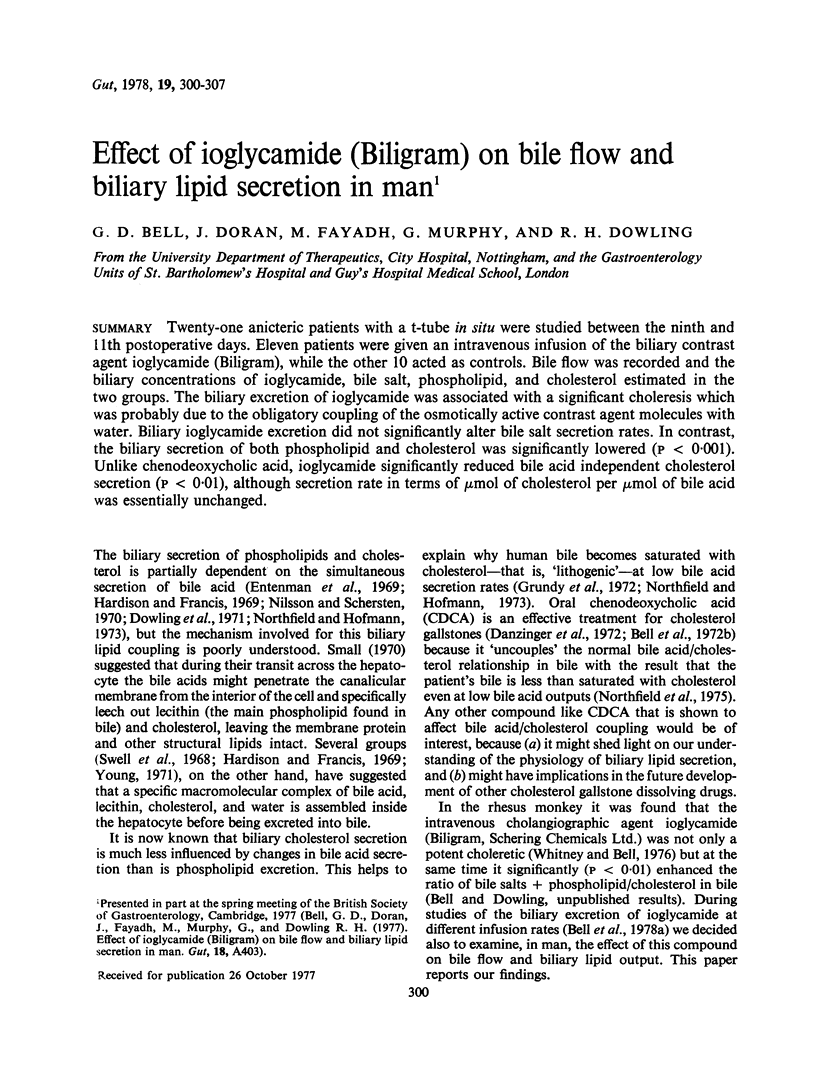
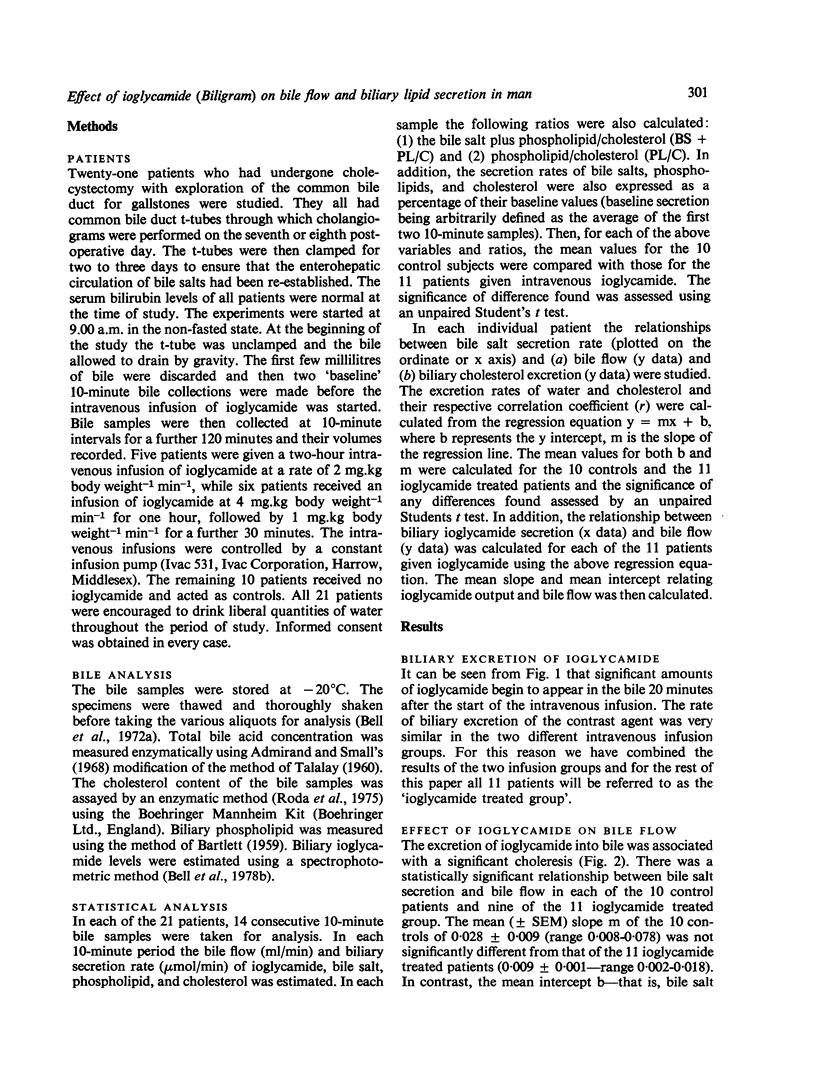
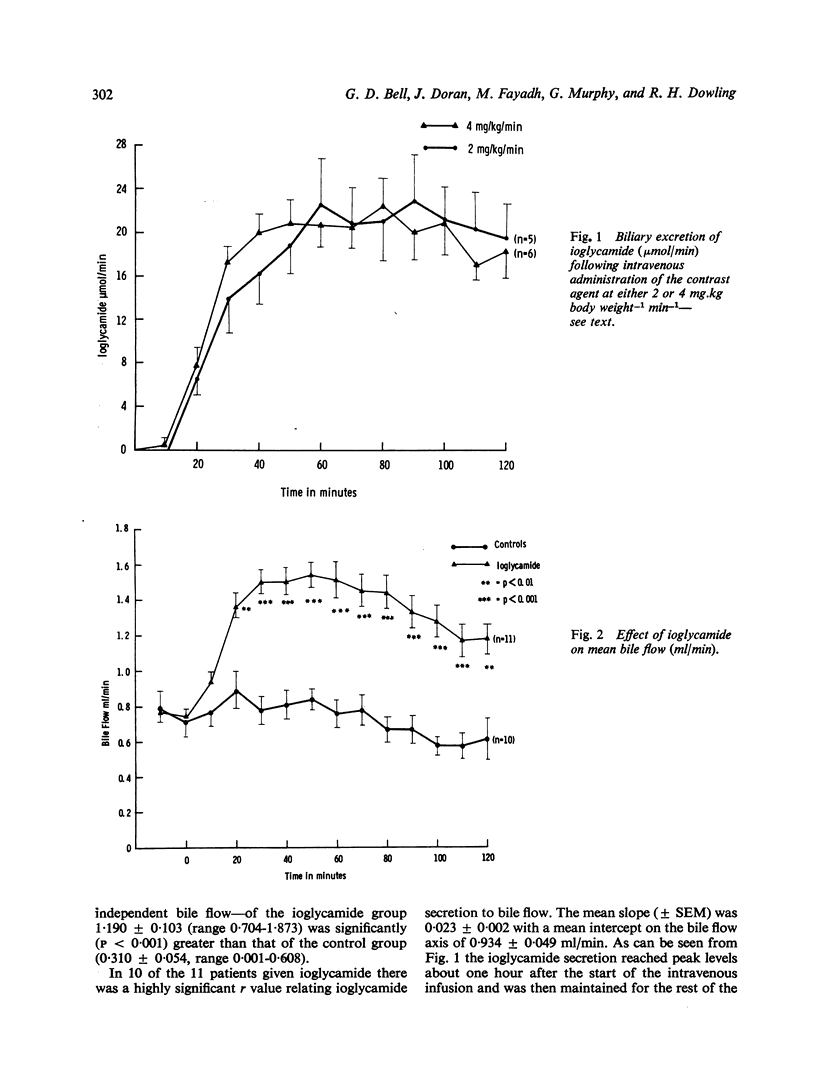
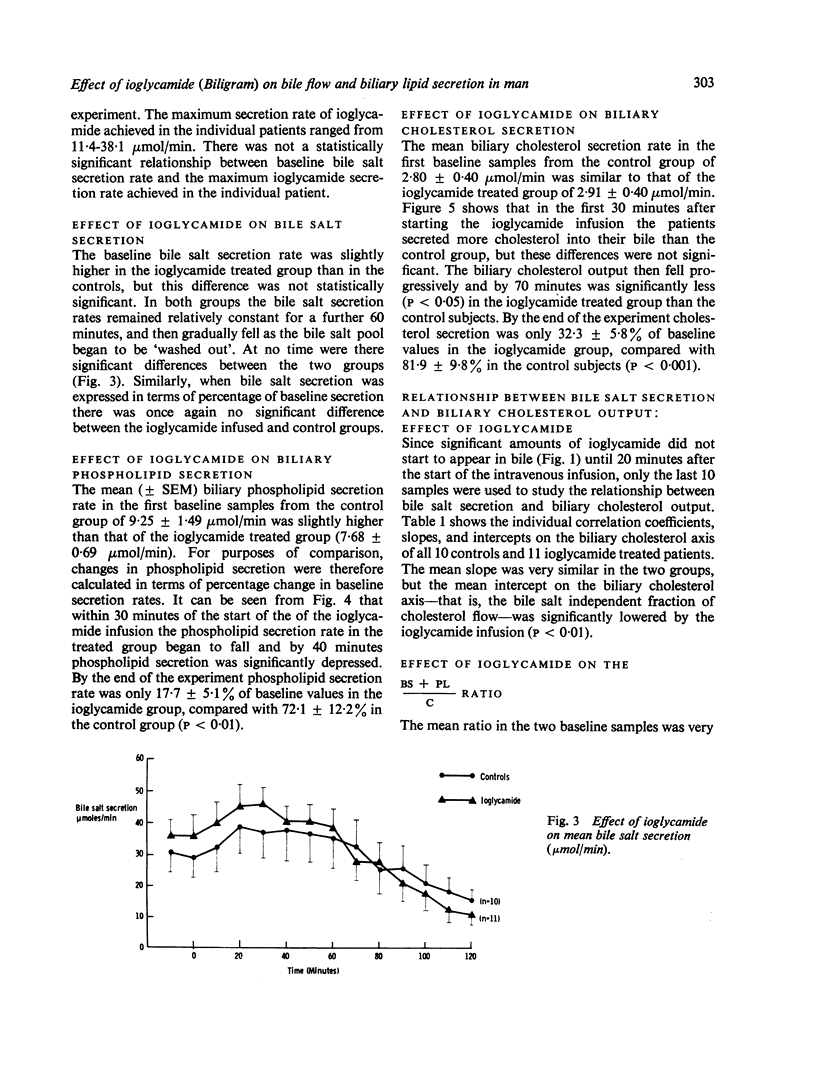
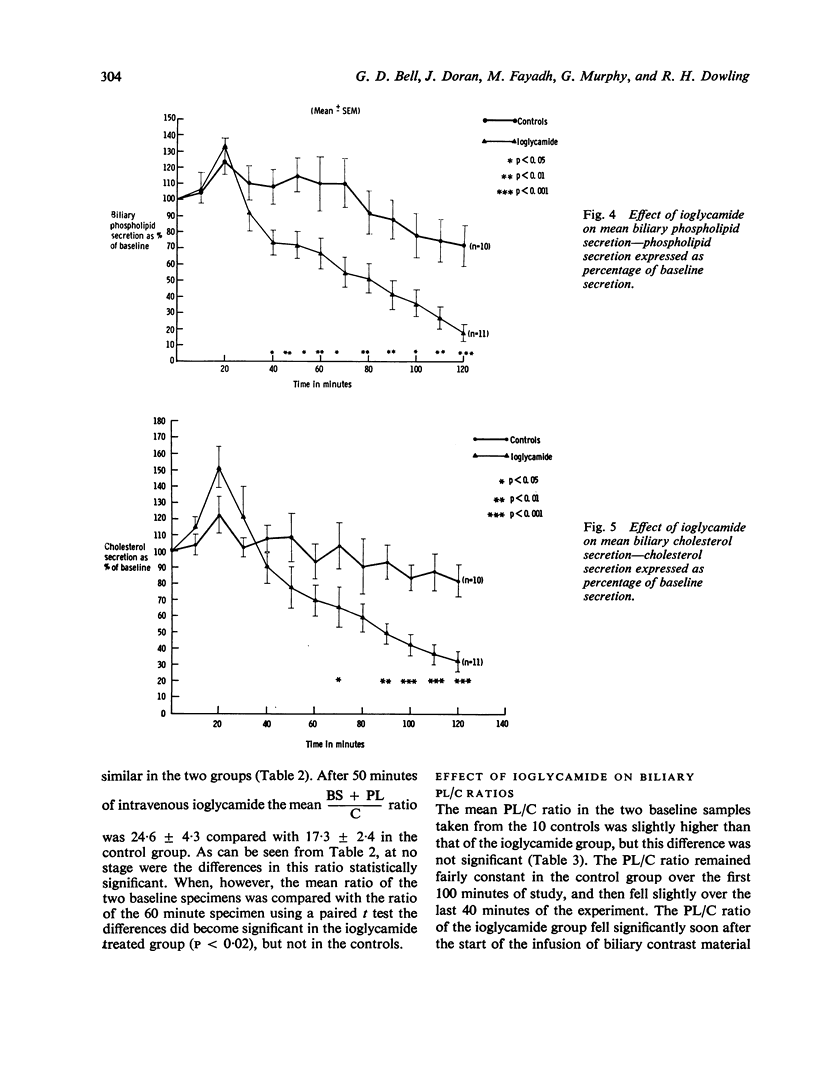
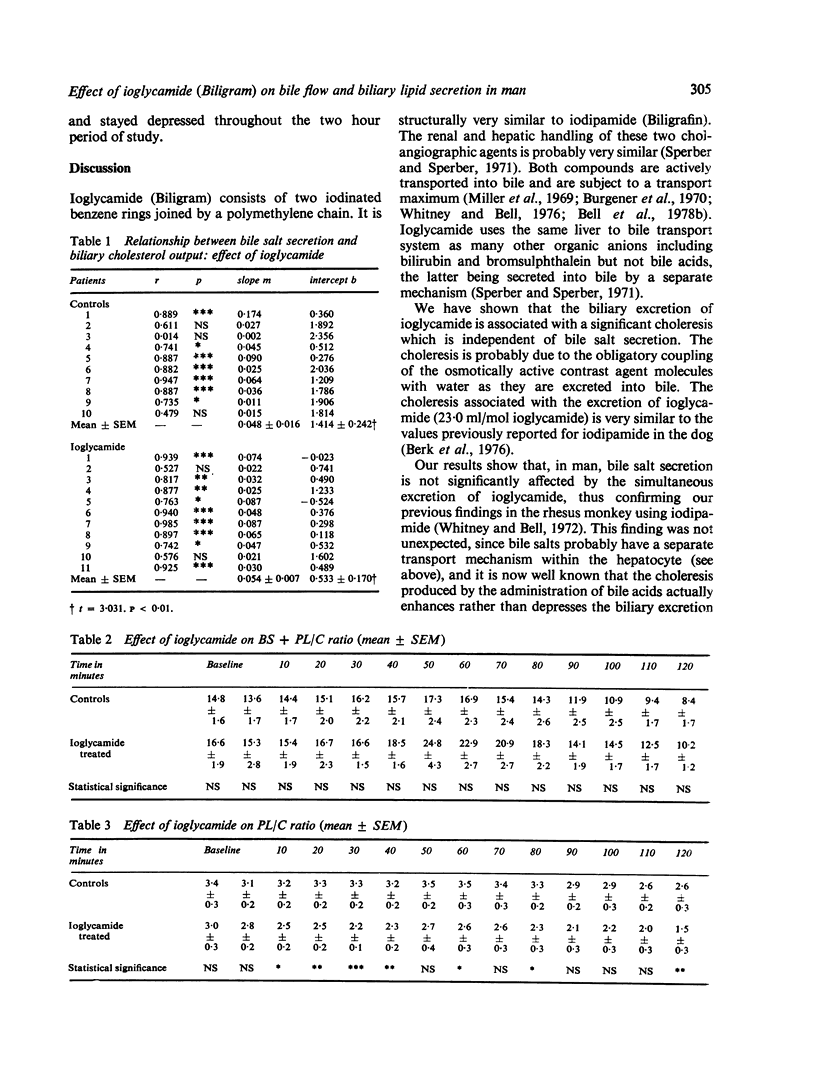
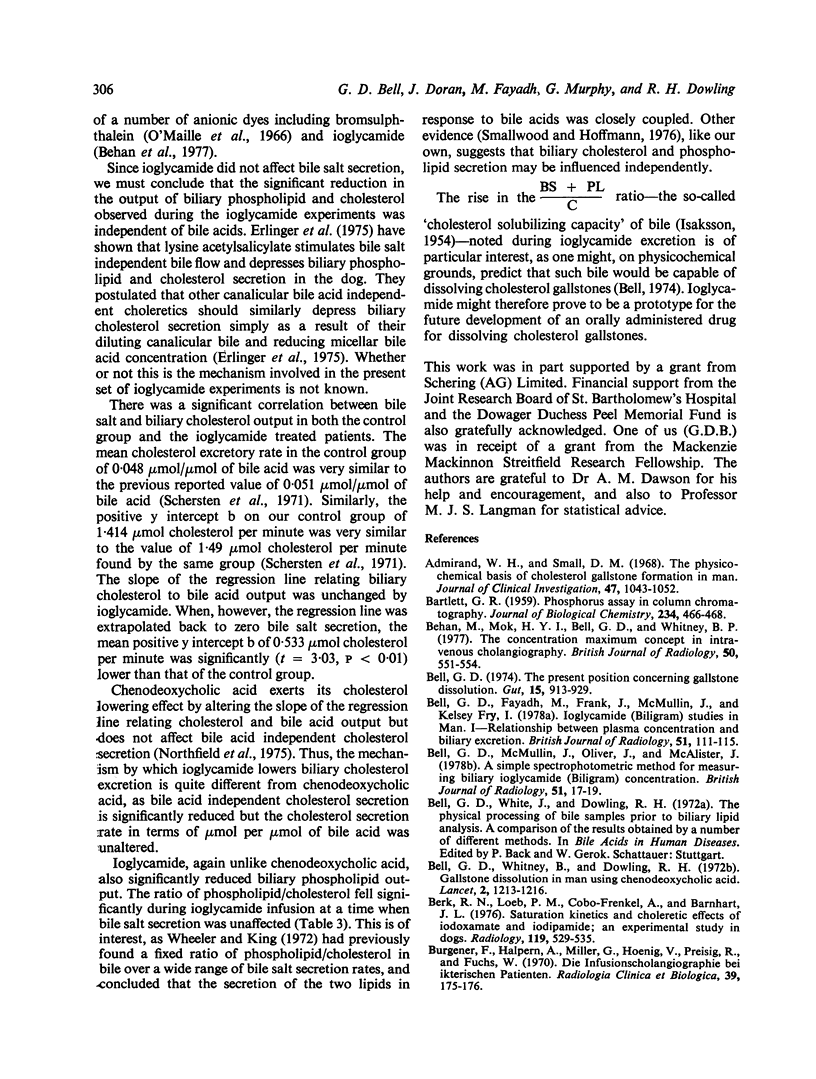
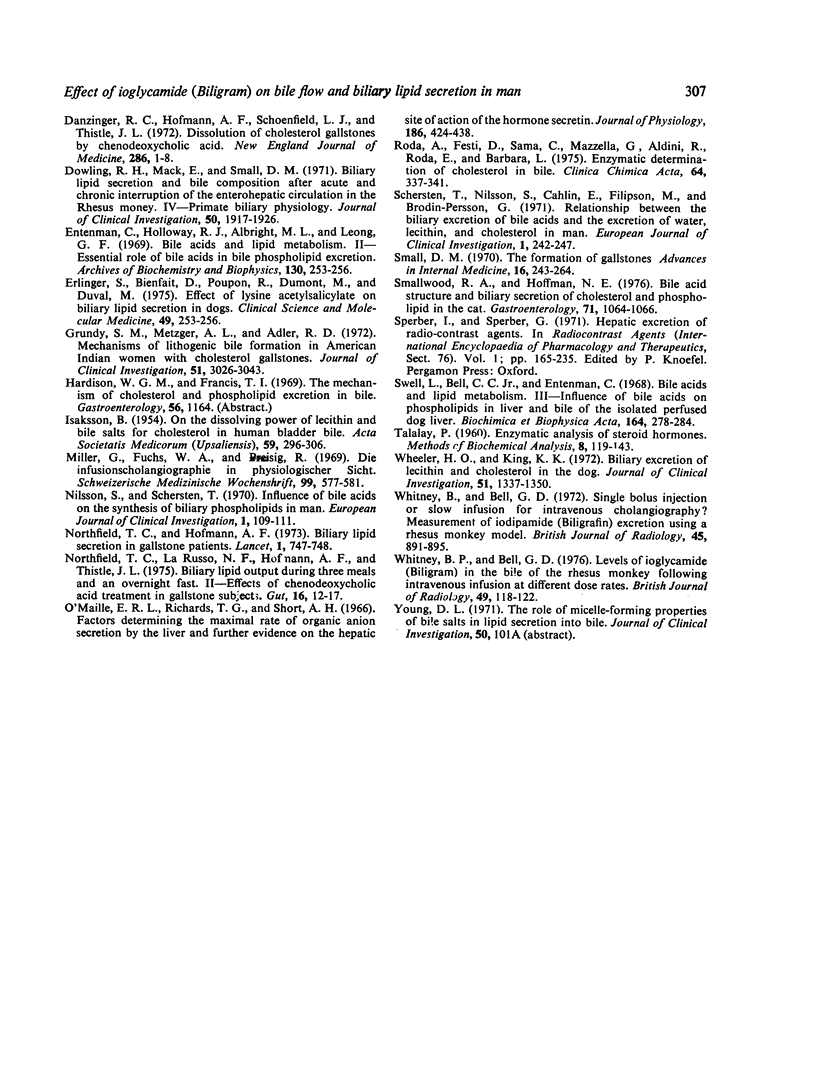
Selected References
These references are in PubMed. This may not be the complete list of references from this article.
- Admirand W. H., Small D. M. The physicochemical basis of cholesterol gallstone formation in man. J Clin Invest. 1968 May;47(5):1043–1052. doi: 10.1172/JCI105794. [DOI] [PMC free article] [PubMed] [Google Scholar]
- BARTLETT G. R. Phosphorus assay in column chromatography. J Biol Chem. 1959 Mar;234(3):466–468. [PubMed] [Google Scholar]
- Behan M., Mok H., Bell C. D., Whitney B. P. The concentration maximum concept in intravenous cholangiography. Br J Radiol. 1977 Aug;50(596):551–554. doi: 10.1259/0007-1285-50-596-551. [DOI] [PubMed] [Google Scholar]
- Bell G. D., Fayadh M., Frank J., McMullin J., Fry I. K. Ioglycamide (Biligram) studies in man--relation between plasma concentration and billary excretion. Br J Radiol. 1978 Feb;51(602):111–115. doi: 10.1259/0007-1285-51-602-111. [DOI] [PubMed] [Google Scholar]
- Bell G. D., McMullin J., Oliver J., McAlister J. A simple spectrophotometric method for measuring biliary ioglycamide (Biligram) concentration. Br J Radiol. 1978 Jan;51(601):17–19. doi: 10.1259/0007-1285-51-601-17. [DOI] [PubMed] [Google Scholar]
- Bell G. D. The present position concerning gallstone dissolution. Gut. 1974 Nov;15(11):913–929. doi: 10.1136/gut.15.11.913. [DOI] [PMC free article] [PubMed] [Google Scholar]
- Bell G. D., Whitney B., Dowling R. H. Gallstone dissolution in man using chenodeoxycholic acid. Lancet. 1972 Dec 9;2(7789):1213–1216. doi: 10.1016/s0140-6736(72)92266-0. [DOI] [PubMed] [Google Scholar]
- Berk R. N., Loeb P. M., Cobo-Frenkel A., Barnhart J. L. Saturation kinetics and choleretic effects of iodoxamate and iodipamide. Radiology. 1976 Jun;119(3):529–536. doi: 10.1148/119.3.529. [DOI] [PubMed] [Google Scholar]
- Burgener F., Halpern A., Miller G., Hoenig V., Preisig R., Fuchs W. A. Die Infusionscholangiographie bei ikterischen Patienten. Radiol Clin Biol. 1970;39(3):175–176. [PubMed] [Google Scholar]
- Danzinger R. G., Hofmann A. F., Schoenfield L. J., Thistle J. L. Dissolution of cholesterol gallstones by chenodeoxycholic acid. N Engl J Med. 1972 Jan 6;286(1):1–8. doi: 10.1056/NEJM197201062860101. [DOI] [PubMed] [Google Scholar]
- Dowling R. H., Mack E., Small D. M. Biliary lipid secretion and bile composition after acute and chronic interruption of the enterohepatic circulation in the Rhesus monkey. IV. Primate biliary physiology. J Clin Invest. 1971 Sep;50(9):1917–1926. doi: 10.1172/JCI106684. [DOI] [PMC free article] [PubMed] [Google Scholar]
- Entenman C., Holloway R. J., Albright M. L., Leong G. F. Bile acids and lipid metabolism. II. Essential role of bile acids in bile phospholipid excretion. Arch Biochem Biophys. 1969 Mar;130(1):253–256. doi: 10.1016/0003-9861(69)90031-9. [DOI] [PubMed] [Google Scholar]
- Erlinger S., Bienfait D., Poupon R., Dumont M., Duval M. Effect of lysine acetylsalicylate on biliary lipid secretion in dogs. Clin Sci Mol Med. 1975 Sep;49(3):253–256. doi: 10.1042/cs0490253. [DOI] [PubMed] [Google Scholar]
- Grundy S. M., Metzger A. L., Adler R. D. Mechanisms of lithogenic bile formation in American Indian women with cholesterol gallstones. J Clin Invest. 1972 Dec;51(12):3026–3043. doi: 10.1172/JCI107130. [DOI] [PMC free article] [PubMed] [Google Scholar]
- ISAKSSON B. On the dissolving power of lecithin and bile salts for cholesterol in human bladder bile. Acta Soc Med Ups. 1954 Sep 30;59(5-6):296–306. [PubMed] [Google Scholar]
- Miller G., Fuchs W. A., Preisig R. Die Infusionscholangiographie in physiologischer Sicht. Schweiz Med Wochenschr. 1969 Apr 19;99(16):577–581. [PubMed] [Google Scholar]
- Nilsson S., Scherstén T. Influence of bile acids on the synthesis of biliary phospholipids in man. Eur J Clin Invest. 1970 Aug;1(2):109–111. doi: 10.1111/j.1365-2362.1970.tb00606.x. [DOI] [PubMed] [Google Scholar]
- Northfield T. C., Hofmann A. F. Biliary lipid secretion in gallstone patients. Lancet. 1973 Apr 7;1(7806):747–748. doi: 10.1016/s0140-6736(73)92130-2. [DOI] [PubMed] [Google Scholar]
- Northfield T. C., LaRusso N. F., Hofmann A. F., Thistle J. L. Biliary lipid output during three meals and an overnight fast. II. Effect of chenodeoxycholic acid treatment in gallstone subjects. Gut. 1975 Jan;16(1):12–17. doi: 10.1136/gut.16.1.12. [DOI] [PMC free article] [PubMed] [Google Scholar]
- O'Máille E. R., Richards T. G., Short A. H. Factors determining the maximal rate of organic anion secretion by the liver and further evidence on the hepatic site of action of the hormone secretin. J Physiol. 1966 Oct;186(2):424–438. doi: 10.1113/jphysiol.1966.sp008044. [DOI] [PMC free article] [PubMed] [Google Scholar]
- Roda A., Festi D., Sama C., Mazzella G., Alini R., Roda E., Barbara L. Enzymatic determination of cholesterol in bile. Clin Chim Acta. 1975 Nov 3;64(3):337–341. doi: 10.1016/0009-8981(75)90364-2. [DOI] [PubMed] [Google Scholar]
- Scherstén T., Nilsson S., Cahlin E., Filipson M., Brodin-Persson G. Relationship between the biliary excretion of bile acids and the excretion of water, lecithin, and cholesterol in man. Eur J Clin Invest. 1971 Jan;1(4):242–247. doi: 10.1111/eci.1971.1.4.242. [DOI] [PubMed] [Google Scholar]
- Small D. M. The formation of gallstones. Adv Intern Med. 1970;16:243–264. [PubMed] [Google Scholar]
- Smallwood R. A., Hoffman N. E. Bile acid structure and biliary secretion of cholesterol and phospholipid in the cat. Gastroenterology. 1976 Dec;71(6):1064–1066. [PubMed] [Google Scholar]
- Swell L., Bell C. C., Jr, Entenman C. Bile acids and lipid metabolism. 3. Influence of bile acids on phospholipids in liver and bile of the isolated perfused dog liver. Biochim Biophys Acta. 1968 Oct 22;164(2):278–284. [PubMed] [Google Scholar]
- TALALAY P. Enzymic analysis of steroid hormones. Methods Biochem Anal. 1960;8:119–143. doi: 10.1002/9780470110249.ch3. [DOI] [PubMed] [Google Scholar]
- Wheeler H. O., King K. K. Biliary excretion of lecithin and cholesterol in the dog. J Clin Invest. 1972 Jun;51(6):1337–1350. doi: 10.1172/JCI106930. [DOI] [PMC free article] [PubMed] [Google Scholar]
- Whitney B. P., Bell C. D. Levels of ioglycamate (Biligram) in the bile of the rhesus monkey following intravenous infusion at different dose-rates. Br J Radiol. 1976 Feb;49(578):118–122. doi: 10.1259/0007-1285-49-578-118. [DOI] [PubMed] [Google Scholar]
- Whitney B., Bell G. D. Single bolus injection or slow infusion for intravenous cholangiography? Measurement of iodipamide (Biligrafin) excretion using a rhesus monkey model. Br J Radiol. 1972 Dec;45(540):891–895. doi: 10.1259/0007-1285-45-540-891. [DOI] [PubMed] [Google Scholar]


